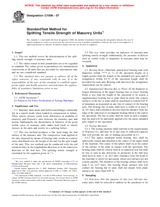We need your consent to use the individual data so that you can see information about your interests, among other things. Click "OK" to give your consent.
ASTM C1006-07
Standard Test Method for Splitting Tensile Strength of Masonry Units
STANDARD published on 1.10.2007
The information about the standard:
Designation standards: ASTM C1006-07
Note: WITHDRAWN
Publication date standards: 1.10.2007
SKU: NS-9030
The number of pages: 3
Approximate weight : 9 g (0.02 lbs)
Country: American technical standard
Category: Technical standards ASTM
Annotation of standard text ASTM C1006-07 :
Keywords:
brick, concrete masonry units, masonry, splitting strength, tensile strength, ICS Number Code 91.100.15 (Mineral materials and products)
Additional information
| Significance and Use | ||
|
Masonry units alone and within assemblages commonly fail in a tensile mode when loaded in compression to failure. These tensile stresses result from differences in modulus of elasticity and Poisson’ratio between the masonry unit and mortar. Additionally, the dissimilarity in behavior of the grout within cores of masonry units under load leads to tensile stresses in the units and results in a splitting failure. This test method produces a line load along the bed surface of the masonry unit. The compressive load applied to the unit, imposed by means of bearing rods, results in a tensile stress distributed over the height of the unit for the split length of the unit. This test method can be conducted with the rod oriented either in the longitudinal direction or in the transverse direction of the bed face. The splitting tensile strength is calculated by the equation given in 7.1. The test value provides an indicator of masonry-unit splitting tensile strength. Additionally, the presence of defects such as visible voids or impurities in masonry units may be revealed. |
||
| 1. Scope | ||
|
1.1 This test method covers the determination of the splitting tensile strength of masonry units. 1.2 The values stated in inch-pound units are to be regarded as standard. The values given in parentheses are mathematical conversions to SI units that are provided for information only and are not considered standard. This standard does not purport to address all of the safety concerns, if any, associated with its use. It is the responsibility of the user of this standard to establish appropriate safety and health practices and determine the applicability of regulatory limitations prior to use. |
||
| 2. Referenced Documents | ||
|
We recommend:
Technical standards updating
Do you want to make sure you use only the valid technical standards?
We can offer you a solution which will provide you a monthly overview concerning the updating of standards which you use.
Would you like to know more? Look at this page.




 Cookies
Cookies
